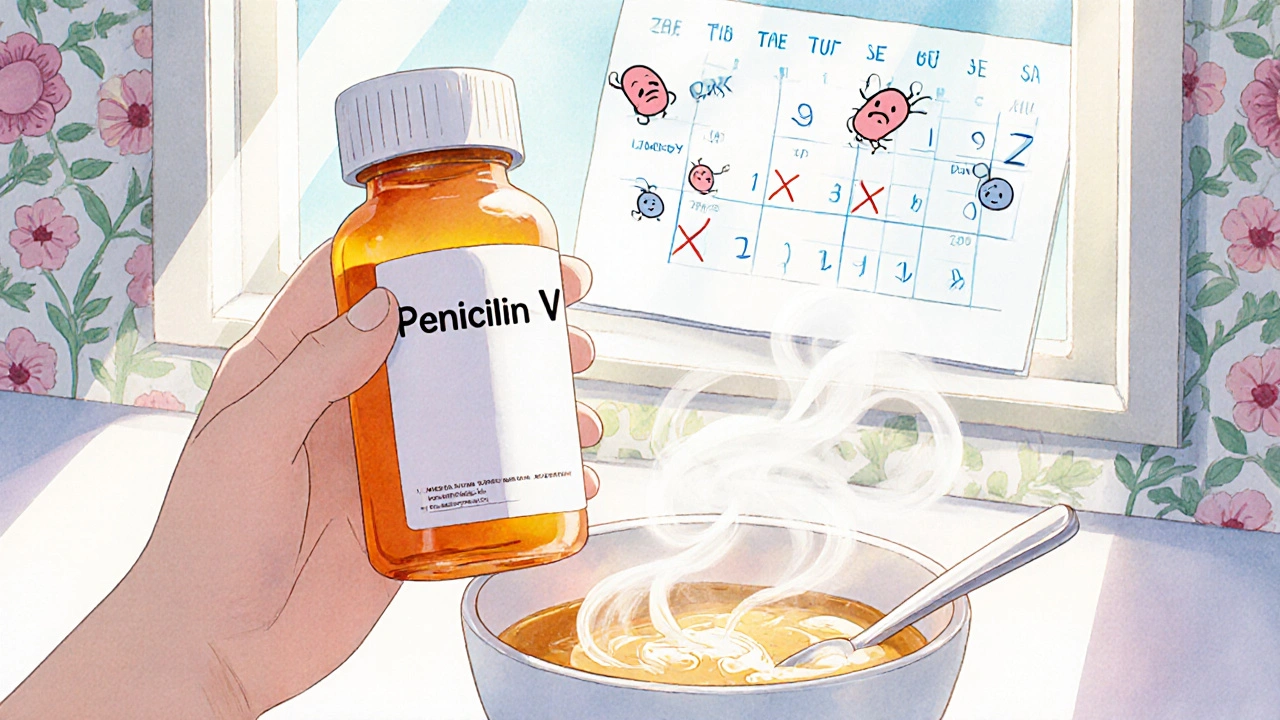What Is Strep Throat?
Strep throat is a bacterial infection caused by Group A Streptococcus (Streptococcus pyogenes). It’s not just a sore throat-it’s a specific, contagious illness that needs proper treatment. Unlike viral colds or flu, strep throat doesn’t come with a runny nose, cough, or red eyes. If you have those symptoms, it’s probably not strep. But if your throat suddenly hurts badly, you have a fever over 100.4°F, and swallowing feels like swallowing glass, it could be strep.
It’s most common in kids between 3 and 9 years old, making up 20-30% of their sore throats. Adults get it too, but less often-only about 5-15% of adult sore throats are strep. Kids under 3 almost never get it. The infection spreads through coughs, sneezes, or sharing cups and utensils. It peaks in winter and early spring, which is why you see more cases from November to April.
How Do You Know It’s Strep Throat?
Doctors don’t guess anymore. They use clear signs and tests. The big red flags are:
- Sudden, severe throat pain
- Fever above 100.4°F (38°C)
- White patches or pus on the tonsils
- Tender, swollen lymph nodes in the neck
- No cough, no runny nose, no congestion
That last one matters a lot. If you’re coughing, it’s likely a virus. Strep throat is silent in the nose and lungs. Another clue? Tiny red spots on the roof of your mouth-called palatal petechiae. They’re rare but very specific to strep.
Doctors use the Centor criteria to estimate your chance of having strep. You get one point for each of these:
- No cough
- Fever over 100.4°F
- Tender neck glands
- White patches on tonsils
If you score 3 or more, you have a 40-60% chance of having strep-and you need a test. Scoring lower? Maybe not worth testing, especially in adults.
How Is Strep Throat Tested?
There are two main tests, and doctors pick based on your age and risk.
The rapid antigen test (RADT) gives results in 10-30 minutes. It’s accurate-over 95% specific-meaning if it’s positive, you have strep. But it can miss about 10% of cases. That’s why in kids and teens, a negative rapid test is followed by a throat culture. Why? Because kids are more likely to develop serious complications like rheumatic fever if strep is missed.
The throat culture is the gold standard. You swab the back of your throat, and the lab grows the bacteria. It takes 24 to 48 hours for results, but it catches almost all cases-90-95% sensitivity. It’s slow, but it’s reliable.
A newer option is molecular testing (PCR). It’s even more sensitive-95-98%-and gives results in 24 hours. It’s becoming more common in urgent care centers and hospitals. In March 2024, the FDA approved a new rapid PCR test called Strep Ultra that gives results in 15 minutes with 98% accuracy. It’s likely to replace older rapid tests soon.
For healthy adults with low risk and a negative rapid test, many doctors skip the culture. But for kids, pregnant women, or anyone with a history of rheumatic fever? Always confirm.

Which Antibiotics Work for Strep Throat?
Antibiotics are the only thing that can truly stop strep throat. They don’t just make you feel better faster-they prevent serious complications like rheumatic fever, which can damage your heart.
The first-choice antibiotic is penicillin V. For adults: 500 mg twice a day for 10 days. For kids: 250 mg twice a day. It’s cheap, effective, and has been used since the 1940s. Only 0.5% of strep strains are resistant to it.
If you’re allergic to penicillin, your doctor will pick one of these:
- Amoxicillin: Often used for kids because it tastes better. Same 10-day course.
- Cephalexin: A cephalosporin, safe for most penicillin allergies (except severe ones).
- Clindamycin: Used if you’re allergic to both penicillin and cephalosporins. Resistance is rising in some areas.
- Azithromycin: A 5-day course. Less effective-only 85-90% success rate-and resistance is around 15% in some regions.
Studies show antibiotics cut symptom duration by about 16 hours. They also make you 80% less contagious after just 24 hours. That’s why you can return to school or work after a full day of antibiotics-once your fever is gone.
Don’t stop antibiotics early just because you feel better. About 40% of parents quit early when symptoms improve. That’s a mistake. Incomplete treatment leads to relapse in 5-15% of cases and increases the risk of rheumatic fever.
How Long Does Recovery Take?
With antibiotics, here’s what to expect:
- Day 1-2: Fever starts dropping. Throat pain begins to ease.
- Day 2-3: Most people feel significantly better. Swallowing is easier.
- Day 4-7: Symptoms are mostly gone. No fever, no pus, no swollen glands.
- Day 7-10: Full recovery. You’ve finished your antibiotics. No more contagiousness.
Without antibiotics, symptoms last 7-10 days, and you stay contagious the whole time. You’re also at risk for complications: ear infections, sinus infections, or worse-rheumatic fever or kidney inflammation.
Even if you feel fine after 3 days, finish the full 10-day course. That’s non-negotiable. A 2023 NEJM study showed 99% eradication with full compliance versus only 85% with partial use.
When Should You Worry?
Most people recover fine. But call your doctor if:
- No improvement after 48 hours of antibiotics
- High fever returns after starting treatment
- Swelling on one side of your throat or difficulty opening your mouth
- Difficulty breathing or swallowing
- Rash, joint pain, or swelling after 1-3 weeks
These could mean complications like a peritonsillar abscess (1-2% of cases), rheumatic fever, or scarlet fever. Rheumatic fever can cause permanent heart damage, especially in kids. That’s why early treatment is so critical.
Also, watch for signs of antibiotic side effects: diarrhea, rash, or yeast infections. If you get a severe rash or swelling, stop the medicine and call your doctor right away.

Common Mistakes People Make
Strep throat is simple to treat-but people mess it up.
- Sharing antibiotics. One in 12 adults have used leftover antibiotics from a past illness. That’s dangerous. Wrong dose, wrong drug, wrong illness.
- Asking for antibiotics for a cough. Antibiotics don’t work on viruses. 30% of outpatient antibiotic prescriptions are unnecessary, according to the CDC.
- Skipping the test. If you feel better after a day of rest, you might think it wasn’t strep. But you could still be contagious and at risk for complications.
- Not testing kids after a negative rapid test. False negatives are more common in young children. Culture is still needed.
And don’t try home remedies as a substitute. Honey and salt water soothe-but they don’t kill the bacteria.
What’s New in Strep Throat Care?
Things are changing fast. In 2024, the CDC invested $15 million to track antibiotic resistance patterns. The IDSA is running a trial to see if a 5-day course of antibiotics works as well as the standard 10-day one. Results are expected in mid-2025.
Point-of-care PCR tests are getting cheaper and faster. By 2026, 40% of urgent care centers might use them. That means same-day results without waiting for the lab.
There’s also a vaccine in development. But it’s tough-there are over 200 strains of Group A Strep, each with slightly different surface proteins. Until we solve that, antibiotics remain our best tool.
Prevention and Long-Term Outlook
There’s no vaccine yet. So prevention is about hygiene:
- Wash hands often
- Don’t share drinks, utensils, or toothbrushes
- Stay home for 24 hours after starting antibiotics
- Replace your toothbrush after 2-3 days of treatment
Strep throat causes 15 million doctor visits in the U.S. every year. It costs $350 million in direct care. But with proper diagnosis and full antibiotic courses, we can prevent 99% of rheumatic fever cases.
The key is simple: test when symptoms match, treat with the right antibiotic, and finish the whole course. That’s how you protect yourself-and others.
Can you get strep throat without a fever?
Yes, but it’s rare. Fever is present in about 85% of confirmed cases. If you have severe throat pain and no fever, it’s more likely viral. Still, if you have white patches, swollen glands, and no cough, you should get tested. Some adults, especially older ones, may not run a high fever even with strep.
Is strep throat contagious after 24 hours of antibiotics?
No. After 24 hours of taking the right antibiotic, you’re no longer contagious. That’s why kids can return to school and adults can go back to work after a full day of treatment-as long as their fever is gone. But you must still finish the full course of antibiotics to prevent relapse or complications.
Can you test positive for strep and not have strep throat?
Yes, but it’s uncommon. A positive rapid test or culture means the bacteria is present. But some people are carriers-they have the bacteria in their throat without symptoms. Carriers don’t need antibiotics unless they’re sick. That’s why doctors rely on symptoms, not just test results. If you have no fever, no pain, and no other signs, a positive test might not mean you need treatment.
Why is penicillin still the first choice for strep throat?
Because it’s cheap, safe, and still works. Only 0.5% of Group A Strep strains are resistant to penicillin. It’s been used for 80 years, and it kills the bacteria completely. Alternatives like azithromycin are less effective and have higher resistance rates. Penicillin also prevents rheumatic fever better than other antibiotics. Unless you’re allergic, it’s the best option.
Can strep throat come back after treatment?
Yes, but it’s usually because the full antibiotic course wasn’t finished. Relapse happens in 5-15% of cases when treatment stops early. It can also happen if you’re exposed again-strep is common in schools and households. If symptoms return after finishing antibiotics, you need to be tested again. It could be a new infection or a treatment failure.
Do I need to see a doctor for every sore throat?
No. Most sore throats are viral and get better on their own. But if you have sudden, severe throat pain, fever over 100.4°F, no cough, swollen glands, or white patches on your tonsils, you should get tested. If you’re a child, pregnant, or have a history of rheumatic fever, don’t wait. Test early. It’s not about fear-it’s about prevention.


Sameer Tawde
November 18, 2025 AT 05:26Just got my kid tested last week-positive on rapid, confirmed by culture. Finished the penicillin, no issues.
Also, replacing the toothbrush after 3 days? Genius. Didn't know that.